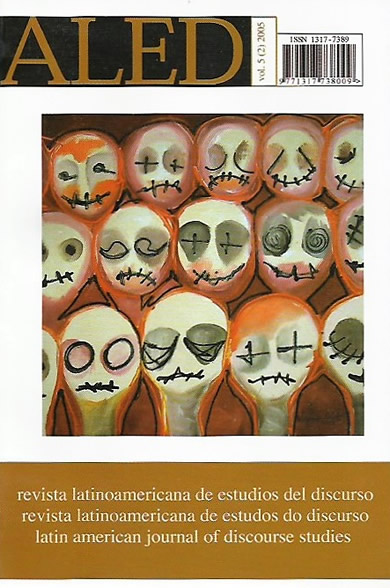Marcos temporales y proyectos comunicativos
el análisis de la temporalidad en la interacción verbal
DOI:
https://doi.org/10.35956/v.5.n2.2005.p.77-94Keywords:
marco temporal. co-construção. teoria dialógica. análise conversacional.Abstract
Our objective in this study is to present the notion of temporal frame as a useful tool for the analysis of verbal interaction in conversation. The concept is first defined in the framework of the dialogical and co-constructionist perspective on language proposed by Per Linell (1998), after which we illustrate how it functions in a series of examples chosen from Mexican telenovela scenes. We then further develop the notion with reference to Halliday’s three semantic metafunctions, and specify some of its structural characteristics, before putting it to the test on an example of fully spontaneous conversation, an argument between a man and a woman recorded on a bus in Mexico City.
Downloads
References
BAKHTIN, M. M. (1981) The dialogic imagination: four essays. C. Emerson &M. Holquist, traductores.Austin: University of Texas Press.
BELL, A. (1991) The language of news media. Oxford: Blackwell.
BENVENISTE, E. (1977) Problemas de lingüística general II. México: Siglo XXIEditores.
FONTE, I. & R. WILLIAMSON (2002) Construyendo la historia a través de lasnoticias: un caso de político fugitivo, Iztapalapa, 53, 23. Julio-diciembre,p. 147-167.
FONTE, I. & R. WILLIAMSON (2003) La co-construcción del diálogo en latelenovela: transacciones verbales y extraverbales, en D. Koike (ed.), La co-construcción del significado en el español de las Américas: acercamientosdiscursivos, pp. 25-52. Ottawa: Legas.
GOFFMAN, E. (1974) Frame analysis: an essay on the organization of experience.Nueva York: Harper & Row.
GRIMSHAW, A. D. (ed.) (1990) Conflict talk:sociolinguistic investigations ofarguments in conversations. Cambridge: Cambridge University Press.
HALLIDAY, M. A.K. (1978) Language as social semiotic: the social interpretationof language and meaning. Londres: Edward Arnold.
HALLIDAY, M. A. K. (1985) An introduction to functional grammar. Londres:Edward Arnold.
HODGE, R. & G. KRESS (1988) Social semiotics. Cambridge: Polity Press.
KOEN, D.B. & W. BENDER (2002) Time frames: temporal augmentation ofthe news, IBM systems journal 39, 3-4: 597-616.
KOIKE, D. (2003) La co-construcción del significado en español: elementospragmáticos de la interacción dialógica, en D. Koike (ed.), La co-construccióndel significado en el español de las Américas: acercamientos discursivos, pp. 11-23. Ottawa: Legas.
LINELL, P. (1998) Approaching dialogue: talk, interaction and contexts in dialogicalperspectives. Amsterdam: Benjamins.
MARTIN, J. R. (1997) Analysing genre: Functional parameters, en F. Christie &J. R. Martin (eds.) Genre and institutions: Social processes in the workplaceand school. Nueva York: Continuum.
PALTRIDGE, B. (1997) Genre, frames and writing in research settings. Amsterdam:Benjamins.
ROMMETVEIT, R. (1990) On axiomatic features of a dialogical approach tolanguage and mind, en I. Marková & K. Foppa (eds.) The dynamics ofdialogue, pp. 83-104. Nueva York: Harvester Wheatsheaf.
ROMMETVEIT, R. (1992) Outlines of a dialogically-based social-cognitiveapproach to human cognition and communication, en A. H. Wold (ed.)The dialogical alternative: Towards a theory of language and mind, pp. 19-44.Oslo: Scandinavian University Press.
SWALES, J. (1990) Genre analysis: English in academic and researchsettings.Cambridge: Cambridge University Press.
TANNEN, D. (1979) What’s in a frame?, en R. Freedle (ed.) New directions indiscourse processing, pp. 137-181. Norwood, NJ: Ablex.
WILLIAMSON, R. & DE DIEGO, F. (2005) Verbo e imagen en la telenovelamexicana.Ottawa: Legas.
Downloads
Published
How to Cite
Issue
Section
License

This work is licensed under a Creative Commons Attribution-NonCommercial-NoDerivatives 4.0 International License.
The authors retain the copyright and guarantee RALED the right to be the first publication of the work as well as a Creative Commons Attribution License that allows others to share the work with recognition of authorship and the initial publication in this journal.




